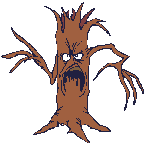
Conclusions

We were very pleased with the numbers we received from Experiment 1 and Experiment 2. All of the numbers from the five runs were similar within the experiments, showing the results would be accurate when averaged. Experiment 3 however we will not include in our conclusions because all the results were based on it having a much larger starting number of Russian Olives than the other two experiments.
The starting number of mature and young trees was random, so it is of no significance that the number of mature trees decreased from the first experiment to the second. This is also the case with the young trees increasing from Experiment 1 to 2. The reason the computer model generated more mature trees than young in the beginning was because it randomly chooses an age for the tree and since there are fewer numbers below 360 than above, there are less young trees.
The fact that the total number of mature trees treated in Experiment 1 decreased in Experiment 2 was surprising. The total number of young trees treated in Experiment 1 increased in Experiment 2. If the number of young trees increased we thought the number of mature trees would have increased as well. This data does support why the number of treatments applied for mature treatments were the same for both treatments but increased in Experiment 2 for the young treatments however.
To eradicate Russian Olives on a riparian area with a starting number of 50 trees and 50 birds it takes an average of 25 months, two mature cut-stump treatments and three young tree cut-stump treatments costing a total of $10,500.
To eradicate Russian Olives on a riparian area with a starting number of 50 trees and 100 birds, it takes an average of 26.6 months, two mature treatments and 3.4 young treatments, costing a total of $12,740.
With these results, it shows that with a higher number of birds in the model it takes longer, needs more treatments, and more money to eradicate the Russian Olives. This is because more birds produce more new trees. This produces a continuous cycle as the Russian Olives provide both food and shelter for the birds.
In order for the eradication of this invasive species, we suggest that using the cut-stump treatments consistently as well as using nets to prevent birds from distributing seeds to be the most efficient.
We consider our greatest accomplishment to be the fact that we were able to get so many real-life variables into the computer model. The variables of trees only being planted near the river, trees being able to get better, and energy being decreased by the cut-stump really made our results possible for real-life modeling.
We hope that others will recognize how important our results are for the thought of invasive species and being able to eradicate them. Computer modeling can be a great tool to experiment with different treatments before applying them in real life. This could save much time, energy and money.